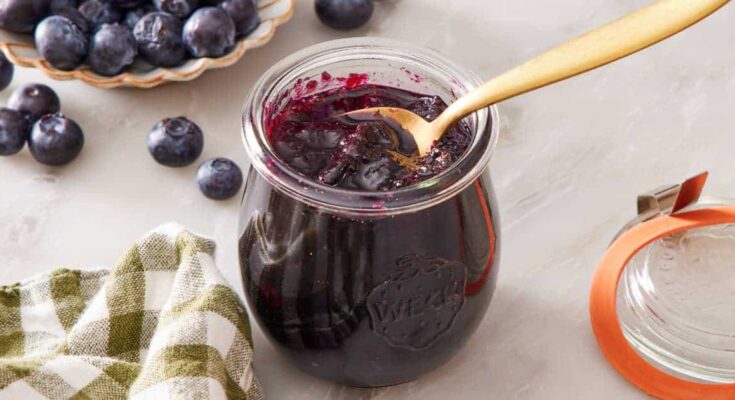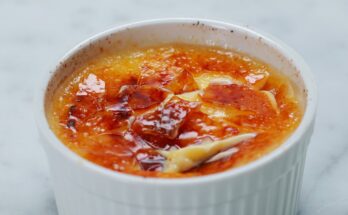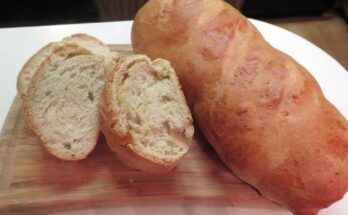Blueberry Confiture Recipe: Let’s start with the basics. Blueberry confiture is a French-style jam made from fresh or frozen blueberries, sugar, and sometimes a touch of lemon juice or pectin to enhance the texture and flavor. It’s smoother than your typical jam, thicker than syrup, and usually richer in berry flavor thanks to its slow-cooked process. This confiture is designed to preserve the natural essence of the blueberries while offering a versatile sweet spread that can be enjoyed in countless ways—from toast to pastries, and even as a glaze for meats or desserts.
While “jam” and “confiture” are often used interchangeably, confiture typically refers to a slightly more refined, silky version that’s common in French cuisine. It’s less chunky, more syrupy, and often highlights the fruit’s natural profile without overpowering it with added pectin or excessive sweetness.
So, if you’re craving something deliciously fruity that feels both rustic and gourmet, blueberry confiture is the answer.
Why You’ll Love This Recipe
There’s something incredibly satisfying about making your own preserves from scratch. Not only do you get to control every ingredient, but you also create a jar of goodness that reflects your taste preferences. Here’s why this blueberry confiture recipe is a keeper:
- Super Simple Ingredients: No weird additives or preservatives.
- Customizable: You can adjust sugar, acidity, and texture to your liking.
- Preservable: Perfect for canning and gifting.
- Versatile: Use it for breakfast, desserts, or even savory dishes.
- Rich Flavor: Slow cooking brings out the deep, luscious taste of blueberries.
By the end of this guide, you’ll be equipped to whip up your own batch of blueberry confiture like a pro. Let’s get into the essentials.
Ingredients You’ll Need
Fresh vs Frozen Blueberries
Before we jump into the list, let’s talk about one of the biggest questions: Should you use fresh or frozen blueberries?
- Fresh blueberries offer the best flavor and texture. If you can get your hands on juicy, ripe berries during peak season, that’s ideal.
- Frozen blueberries are a great alternative, especially off-season. They’re picked and frozen at peak ripeness, so you still get great flavor.
Pro Tip: If using frozen, thaw them fully and drain off any excess water before cooking to avoid a watery confiture.
Full Ingredients List
Here’s what you’ll need for a classic blueberry confiture:
- 4 cups (about 600g) of fresh or frozen blueberries
- 1 ½ cups (300g) of granulated sugar (adjust to taste)
- 1 tbsp lemon juice (freshly squeezed)
- Zest of 1 lemon (optional, for added citrus brightness)
- 1 tsp vanilla extract (optional, adds a warm aroma)
- ½ tsp cinnamon or nutmeg (optional, for spiced variation)
That’s it. No preservatives, no pectin, no thickeners—just real, wholesome ingredients.
Optional Add-Ins to Elevate the Flavor
Want to make your confiture more unique? Try these optional twists:
- Lavender buds: For a floral aroma.
- Chia seeds: Natural thickener and adds nutrients.
- Rosemary sprig: Great for savory pairings.
- A splash of balsamic vinegar: Deepens the flavor and adds tang.
Feel free to experiment, but always start small—just a pinch or drop can change the flavor dramatically.
Tools and Equipment Needed
Kitchen Essentials
Making blueberry confiture doesn’t require fancy gear, but having the right tools can make the process smoother. Here’s what you’ll need:
- Medium to large saucepan or Dutch oven (heavy-bottomed to prevent burning)
- Wooden spoon or heatproof silicone spatula (for stirring)
- Potato masher or fork (to break down berries)
- Candy or jam thermometer (optional, for precision)
- Small plate (chill in freezer) (used to test the setting point)
You likely have most of these in your kitchen already.
Storage Jars and Canning Tips
For storage, you’ll need:
- Sterilized glass jars with lids (4–6 small jars or 2–3 medium ones)
- Tongs and funnel (makes jar filling cleaner and easier)
- Large pot for water bath canning (if preserving for longer shelf life)
Sterilizing Your Jars: Boil your jars and lids for 10 minutes, or run them through the dishwasher on a hot cycle. Always fill hot jam into hot jars to prevent cracking.
Preparation Tips Before You Start
How to Wash and Sort Blueberries
Start by inspecting your blueberries. Remove any stems, leaves, or damaged fruit. Then, gently rinse them in cold water. Let them drain completely in a colander.
If you’re using frozen berries, make sure they are thawed and patted dry before starting to prevent a watery jam.
Quick Tip: Place blueberries on a clean kitchen towel and gently roll them dry. This helps reduce water content that can affect the final texture.
Prepping Your Jars for Storage
Sterilization is key for preserving any confiture or jam. Here’s how to prep your jars:
- Wash jars and lids with hot soapy water.
- Place them in a large pot filled with water.
- Boil for 10 minutes, then keep warm until ready to fill.
- Dry thoroughly before adding confiture.
Why it matters? Skipping sterilization can lead to bacteria growth, mold, or fermentation. It’s an extra step but absolutely worth it for freshness and safety.
Step-by-Step Guide to Making Blueberry Confiture
Let’s break down the entire process, one step at a time.
Step 1: Combine Ingredients
Add your blueberries to a large saucepan. Pour in the sugar, lemon juice, and any optional ingredients like zest or vanilla.
Stir gently to combine. Let the mixture sit for 10-15 minutes off the heat. This step helps draw out natural juices from the berries, starting the dissolving process of the sugar.
Step 2: Cook the Mixture
Once your ingredients are combined and rested, it’s time to bring everything to life. Turn the heat to medium and slowly bring the mixture to a gentle simmer. Stir frequently with a wooden spoon or spatula to avoid burning, especially at the bottom of the pan.
As the blueberries heat up, they’ll begin to burst open and release their juices. You can use a potato masher to help them break down further if you prefer a smoother consistency. If you like your confiture with some whole berries, go easy on the mashing.
Keep the heat at a steady simmer—not a boil. The goal is slow reduction. This process should take around 20 to 30 minutes. Patience is key here. Stir regularly to prevent scorching and ensure even cooking.
As the sugar melts and the fruit breaks down, you’ll see the mixture start to thicken and darken into a rich, glossy deep purple hue. That’s when the magic begins.
Step 3: Monitor the Texture
Texture is everything in a good confiture. So how do you know it’s the right thickness? Unlike commercial jams, which rely heavily on pectin, this homemade blueberry confiture achieves its consistency through slow cooking and natural fruit sugars.
There are a few signs your mixture is reaching the right stage:
- The mixture coats the back of your spoon and leaves a trail when you run your finger through it.
- It bubbles slowly, not like a rolling boil but with heavier, thicker bubbles that resemble lava.
- The volume reduces visibly and the color deepens into a jammy blue-violet shade.
Remember, confiture continues to thicken as it cools. So even if it seems a little runny in the pot, it will set up once jarred and chilled.
Step 4: Test for Doneness
There’s an old-school trick to know if your confiture is ready: the cold plate test.
Here’s how to do it:
- Take a small plate that’s been in the freezer.
- Drop a spoonful of the hot confiture onto it.
- Wait 30 seconds, then run your finger through the blob.
- If the line you create stays in place, it’s done. If it floods back together, it needs more cooking.
If you’re more technical, a jam thermometer should read about 220°F (104°C) for perfect gel setting.
Don’t rush this step. Undercooked confiture will be too runny and spoil quicker. Overcooked, and it may caramelize or become rubbery.
Step 5: Jar and Store
Once your blueberry confiture reaches that ideal, jammy consistency, it’s time to get it into jars.
Here’s how to do it safely and effectively:
- Remove the pot from heat and let it sit for 5–10 minutes. This lets bubbles settle and prevents foam on top.
- Use a ladle and a funnel to fill sterilized jars, leaving about ¼-inch of space at the top.
- Wipe the rims clean with a damp towel to ensure a tight seal.
- Secure the lids and screw on the bands just fingertip-tight.
If you plan to store the confiture short-term, let the jars cool at room temperature, then refrigerate. It will last for up to 3 weeks in the fridge.
For long-term storage, proceed with water bath canning:
- Submerge sealed jars in boiling water for 10 minutes.
- Remove and let cool undisturbed for 12–24 hours.
- Listen for the “pop” as lids seal.
Once sealed, your confiture is shelf-stable for up to a year. Just make sure it’s stored in a cool, dark place.
Tips for Perfect Confiture Every Time
Common Mistakes to Avoid
Even though it’s a simple recipe, small mistakes can throw things off. Here are the most common missteps and how to dodge them:
- Overcooking: If the confiture gets too thick in the pot, it’ll be rubbery in the jar. Keep a close eye and do regular texture checks.
- Too much sugar: More isn’t always better. Too much sugar can overpower the blueberry flavor. Start with the recommended amount and adjust gradually.
- Skipping the lemon juice: Don’t omit it! Lemon juice isn’t just for flavor—it helps balance the sweetness and assists in setting the confiture by activating natural pectin.
- Not sterilizing jars properly: This can lead to spoilage or contamination. Always sterilize, even for fridge storage.
Adjusting Sugar and Acidity
Everyone has a different palate. Maybe you want it sweeter, tangier, or less sugary. Here’s how to tweak the recipe:
- Less sugar: Reduce sugar by up to 25%, but note that the confiture may be thinner and spoil faster.
- More acidity: Add more lemon juice or zest for brightness, especially if your berries are super sweet.
- Add natural thickeners: If cutting sugar, consider adding a tablespoon of chia seeds for a natural thickening boost.
Always taste as you go, especially before jarring. You can still adjust the flavor in the final minutes.
Storing and Preserving Blueberry Confiture
Short-Term Storage
If you’re planning to use your blueberry confiture within a few weeks, short-term refrigeration is your best bet.
Here’s what you need to know:
- Store in airtight, sterilized glass jars.
- Keep in the fridge at or below 40°F (4°C).
- Use a clean spoon every time you scoop to prevent contamination.
- Shelf life: 2–3 weeks, maximum.
Label the jar with the date you made it so you can keep track easily.
Long-Term Canning and Preservation
Want your blueberry confiture to last all year? Canning is the answer. It extends shelf life up to 12 months or more.
Follow these key steps:
- Fill sterilized jars while the confiture is hot.
- Leave a little headspace to allow for vacuum sealing.
- Process jars in a boiling water bath for at least 10 minutes.
- Cool jars upright and undisturbed. Check for sealed lids (they shouldn’t bounce when pressed).
- Store in a cool, dark pantry or cupboard.
Always check for spoilage signs before consuming—like mold, off smell, or lid bulging.
How to Use Blueberry Confiture
Breakfast Ideas
This confiture is the MVP of your breakfast table. Here are some ways to enjoy it first thing in the morning:
- Spread it on buttered toast, bagels, or English muffins
- Swirl it into Greek yogurt or oatmeal
- Add it between pancake layers with a dollop of whipped cream
- Spoon it onto waffles or crepes
- Use it as a base for smoothie bowls
A little goes a long way, and the flavor payoff is immense. It’s the kind of breakfast upgrade that feels fancy, even if you’re still in pajamas.
Desserts and Baking Uses
This isn’t just a toast topper—it’s a dessert enhancer too:
- Dollop it over cheesecake or ice cream
- Use it as a filling for thumbprint cookies, danishes, or tarts
- Fold it into cake batter for a fruity twist
- Add it between layers of a Victoria sponge cake
- Mix into buttercream for a berry-flavored frosting
Blueberry confiture is rich but not overpowering, making it a perfect pair for creamy or baked desserts.
Creative Pairings You’ll Love
Get creative and take your confiture beyond the expected:
- Pair with brie or goat cheese on a charcuterie board
- Use as a glaze for pork chops or grilled chicken
- Stir into cocktails or mocktails for a fruity twist
- Add a spoonful to hot tea or sparkling water for a homemade infusion
Once you’ve made your first jar, you’ll be surprised how often you reach for it. It’s addictive—in the best way.
Nutritional Benefits of Blueberries
Packed With Antioxidants
Blueberries are one of nature’s most powerful superfoods, and the best part is—they don’t lose their magic when turned into confiture. These tiny berries are loaded with antioxidants, especially anthocyanins, which are responsible for their deep blue color and many of their health benefits.
Here’s what makes them so special:
- Fight free radicals: Antioxidants help neutralize unstable molecules that cause oxidative stress, which is linked to aging and diseases.
- Anti-inflammatory properties: Blueberries are known to reduce inflammation in the body, helping improve overall immune function.
- Brain health: Studies have shown that regular consumption of blueberries may enhance memory and cognitive function.
- Heart protection: These berries are associated with reduced blood pressure and lower LDL cholesterol levels, contributing to heart health.
Even though some nutrients degrade during cooking, many of the powerful polyphenols in blueberries remain intact, especially in a carefully prepared confiture. So you’re still getting a healthy dose of goodness with every spoonful.
Health-Boosting Nutrients
Aside from antioxidants, blueberries bring a variety of essential nutrients to the table. Here’s a breakdown of the main health perks per serving:
| Nutrient | Benefit |
|---|---|
| Vitamin C | Supports immune health and skin regeneration |
| Vitamin K | Essential for bone health and blood clotting |
| Fiber | Aids digestion and helps regulate blood sugar |
| Manganese | Important for bone development and metabolism |
Blueberries are naturally low in calories but high in nutrients, making them a smart addition to any diet—even in sweet form like a confiture.
Variations and Flavor Combinations
Lemon, Vanilla, and Lavender Infusions
Want to add a gourmet twist to your classic blueberry confiture? These infusions can take it to the next level:
- Lemon & Vanilla: A teaspoon of vanilla extract and zest from one lemon add depth, warmth, and a burst of citrus. This combo is perfect for pairing with baked goods or breakfast dishes.
- Lavender: Add a teaspoon of dried culinary lavender during the simmering process (strain before jarring). This floral note complements the tartness of the berries beautifully—especially good for high-tea spreads or desserts.
- Honey & Thyme: Swap half the sugar for honey and toss in a small sprig of thyme for an earthy, sweet-savory finish.
Always add these ingredients in moderation—just a little can completely shift the flavor profile. Test in small batches if you’re experimenting.
Spiced Blueberry Confiture
Add a cozy, warm spice profile that’s perfect for fall or holiday seasons. Consider these add-ins:
- Cinnamon stick or ground cinnamon for classic warmth
- Nutmeg or clove for depth and richness
- Star anise for a hint of licorice
- Fresh ginger for zing and a slight kick
These flavors pair especially well when the confiture is used in pastries, breakfast spreads, or even meat glazes. Don’t overdo it—start with a pinch or a small stick and taste as you go.
Troubleshooting Your Blueberry Confiture
Why Is My Confiture Too Runny?
A runny confiture can happen even to experienced cooks. Here are some common reasons and how to fix them:
Causes:
- Not cooked long enough (the most common issue).
- Too little sugar or acid (both affect gelling).
- Overripe or underripe fruit with low pectin content.
Fixes:
- Return to the stove and cook longer, stirring frequently.
- Add a splash of lemon juice or a small amount of pectin.
- Add a tablespoon of chia seeds and let it sit—this natural thickener works wonders without changing the taste much.
Also, remember that jam always thickens as it cools. Don’t rush to fix it before it’s had time to set fully (usually 12–24 hours).
How to Fix Overcooked Jam
On the flip side, overcooked confiture can turn stiff, gummy, or even taste slightly burnt.
Here’s how to rescue it:
- Add a few tablespoons of water or fresh lemon juice and gently reheat over low heat until it loosens up.
- If it’s completely scorched, there’s not much you can do. Scrape off the top layer (if not burnt) and start over with a fresh batch.
Prevention is key. Use a thermometer, do the plate test often, and stir frequently to avoid sticking or caramelizing at the bottom.
FAQs about Blueberry Confiture Recipe
Can I use less sugar in this recipe?
Yes, but reducing sugar can affect texture and shelf life. Consider adding chia seeds or store in the fridge for short-term use.
Do I need to add pectin?
Not necessarily. Blueberries have natural pectin, and lemon juice helps enhance it. For a firmer set, a little pectin is okay but optional.
How long does homemade blueberry confiture last?
- In the fridge: up to 3 weeks
- Sealed and canned: up to 1 year
Can I freeze blueberry confiture?
Absolutely! Just use freezer-safe containers and leave room for expansion. Thaw in the fridge before using.
What’s the difference between jam, jelly, and confiture?
- Jam: Made with mashed fruit and sugar.
- Jelly: Made with fruit juice and sugar—no chunks.
- Confiture: French term for jam, often silkier and slightly looser in consistency.
Conclusion
Making your own blueberry confiture at home isn’t just a delicious project—it’s a rewarding one. From the aroma of simmering berries to the satisfying pop of the sealed lid, every step is packed with rustic charm and gourmet delight.
Whether you spoon it over pancakes, swirl it into desserts, or give it as a thoughtful gift, this versatile spread will quickly become a staple in your kitchen. And the best part? You can tweak, twist, and flavor it exactly how you like.
So grab some berries, fire up the stove, and let your culinary creativity flow. Once you taste your homemade blueberry confiture, there’s no going back to store-bought.



